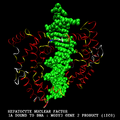Members
The following is a list of human hepatocyte nuclear factors (see also boxes to the right for additional information about these proteins):
HNF1
Members of the HNF1 subfamily contain a POU-homeodomain and bind to DNA as homodimers.
|
| ||||||||||||||||||||||||||||||||||||||||||||||||||||||||||||||||||
HNF3
The HNF3 subfamily members contain a winged helix DNA-binding domain and bind to DNA as monomers.
- HNF3α/FOXA1 (forkhead box A1)
- HNF3β/FOXA2 (forkhead box A2)
- HNF3γ/FOXA3 (forkhead box A3)
|
|
| ||||||||||||||||||||||||||||||||||||||||||||||||||||||||||||||||||||||||||||||||||||||||||
HNF4
Members of the HNF4 subfamily are nuclear receptors and bind to DNA either as homodimers or RXR heterodimers.
|
| ||||||||||||||||||||||||||||||||||||||||||||||||||||||||||||||||
HNF6
The HNF6 subfamily members contain a cut-homeodomain (ONECUT) bind to DNA as monomers.
|
| ||||||||||||||||||||||||||||||||||||||||||||||||||||||||||||


